Today, I am posting a personal experiment of mine to answer some questions I have about the discernible differences a mouthpiece patch and the mouthpiece beak height make to the sound of the saxophone. I know many of you out there will perhaps think this is foolish but I am doing this to satisfy my own personnel curiosity.
Lamberson J7 Tenor Saxophone Mouthpiece with No Mouthpiece Patch
These questions of mine started a long time ago when I was playing the saxophone in college. I remember my sax teacher at the time telling me that I could put a mouthpiece patch of some tape or rubber onto the beak of my sax mouthpiece to prevent the deep teeth marks I was putting in my saxophone mouthpieces at the time.
This was good news for me because every mouthpiece I had played had deep teeth gouges worn into the beak of each mouthpiece. I know, I know, we are not supposed to bite like that while playing the saxophone, but I was a young energetic alto sax player trying to sound like Dave Sanborn and Mark Russo and biting just seemed to get me closer to that goal at the time. I apologize for not being a good saxophone playing role model in my younger years……..
Lamberson J7 Saxophone Mouthpiece with One Forestone Mouthpiece Patch
Upon trying a patch on my mouthpiece back then, I noticed an immediate change in my saxophone sound. For classical music, this change was fine but for my jazz playing, I felt like the patch really effected my tone in a negative way. The mouthpiece patch seemed to dull the tone and take some of the highs and brights that I loved in my sound away. At least that was my impression as I played my saxophone with a patch on my mouthpiece.
The sound I was used to hearing through my ears and inside my head while playing was completely changed and I did not like that. I was at a point where I was really starting to dig that sound I was producing and hearing while I played, the last thing I wanted to do was to change what I was hearing while playing.
Lamberson J7 Saxophone Mouthpiece with Two Forestone Mouthpiece Patches
Besides just having my tone effected, I also had a harder time hearing myself while playing gigs with live bands with a mouthpiece patch on my mouthpiece. I could not hear myself on loud gigs and when I took the mouthpiece patch off, I could then hear myself again. This fact, combined with the impression that the patches lessened the highs, brights and edge in my saxophone sound, convinced me to give up on the mouthpiece patch idea at the time.
Years later, when I started trying out different saxophone mouthpieces, I would revisit mouthpiece patches again and I have been using them ever since on my mouthpieces to protect them. But still, even today, I find myself wondering what, if any, perceivable difference a mouthpiece patch makes to the saxophone tone from the perspective of the listener.
I have read many views and opinions on this subject on the internet over the years that say a mouthpiece patch can make a difference in sound to the player because it dulls the vibrations traveling through the mouthpiece, into the teeth, up the jaw and to the ears of the player, but the difference to the audience is insignificant and negligible. Some have written that there is no difference to the listener whatsoever. Still, how could such a drastic change in tone be so obvious to me the player, but the listener hears no difference whatsoever?
Lamberson J7 Saxophone Mouthpiece with Three Forestone Mouthpiece Patches
Lamberson J7 Saxophone Mouthpiece with Four Forestone Mouthpiece Patches
Please keep in mind that everything I have stated so far in this article has been based on my subjective impressions, experiences, opinions and random stuff I have read on the internet. The point of this article was to record some clips of me playing the same thing with a different variety of mouthpiece patches on my mouthpiece and to see if the differences I hear in my head are at all perceivable on the recordings.
Lamberson J7 Saxophone Mouthpiece with Six Forestone Mouthpiece Patches
On the seven clips below, I play the beginning melody to “My One and Only Love” on the tenor saxophone with a Lamberson J7 tenor saxophone mouthpiece. The first clip is with no mouthpiece patch and my front teeth are just sitting on the hard rubber. I honestly have not attempted to play without a patch like this in over 15 years I think.
In my head and ears, playing this first clip was almost unbearable! The tone was incredibly loud, bright and edgy. The sound in my head sounded so loud and bright that it felt like if I played like that all the time, I would probably lose the last of my hearing in my one good ear that is left.
The second clip is how I usually play with one mouthpiece patch on the mouthpiece. The volume in my head was more “under control” and was no longer unbearable. The highs and brights also seemed to be less which to my ear was a good difference and change.
For the sake of this article, I wanted to experiment with thicker patches to reproduce the feel of a higher mouthpiece beak profile for the sound clips. I recorded a clip with 2, 3, 4 and 6 mouthpiece patches piled on top of each other.
Lamberson J7 Saxophone Mouthpiece played with a Ridiculously Thick Piece of Rubber on the Mouthpiece Beak
Lastly, just for the heck of it, I decided to try playing with a thick piece of rubber between my top teeth and the mouthpiece (as seen in the photo above). I used a rubber SYOS mouthpiece cap for this experiment and it was definitely not easy or comfortable but I wanted to see if that simulated higher beak profile would indeed make a difference in the perceived sound to the listener. I had difficulty tonguing from this higher beak position and did not tongue the beginning notes of the melody like I did in the rest of the clips.
Listen to the sound clips below and let me know what you think in the comments below. I found it helpful to listen to one segment of a clip and then play the same segment on the next clip and so on. If you hear no difference whatsoever, that is fine, let me know. If you do hear a difference between any of the clips, let me know that as well. I tried to keep the clips as similar as possible but there are indeed some differences between the clips as far as my playing (it’s so hard to make someone who loves to improvise play the same exact thing over and over again…….)
Thanks for taking the time to listen. Let me know what you think in the comments below. Steve
*Please keep in mind that the better your speakers and sound system are, the more details you will hear in these clips. Listening on your old iPhone while you ride the subway will probably not give you optimal results……….
*The sound clips below are lossless wave files for the most realistic sound and best quality.
PS. I swear I can hear a slight difference between the first note of each clip but is this my mind playing games on me or does the mouthpiece patch make a difference? Does the first clip sound more vibrant? I swear it does but then again, my brain might be hearing what it expects to hear. Could I pick out this difference if the tracks were mixed up and it was a blind test? Now that would be hard…….. You decide for yourself………
Lamberson J7 Sax Mouthpiece with No Patch
Lamberson J7 Sax Mouthpiece with One Patch
Lamberson J7 Sax Mouthpiece with Two Patches
Lamberson J7 Sax Mouthpiece with Three Patches
Lamberson J7 Sax Mouthpiece with Four Patches
Lamberson J7 Sax Mouthpiece with Six Patches
Lamberson J7 Sax Mouthpiece with A Big Thick Piece of Rubber Over Beak
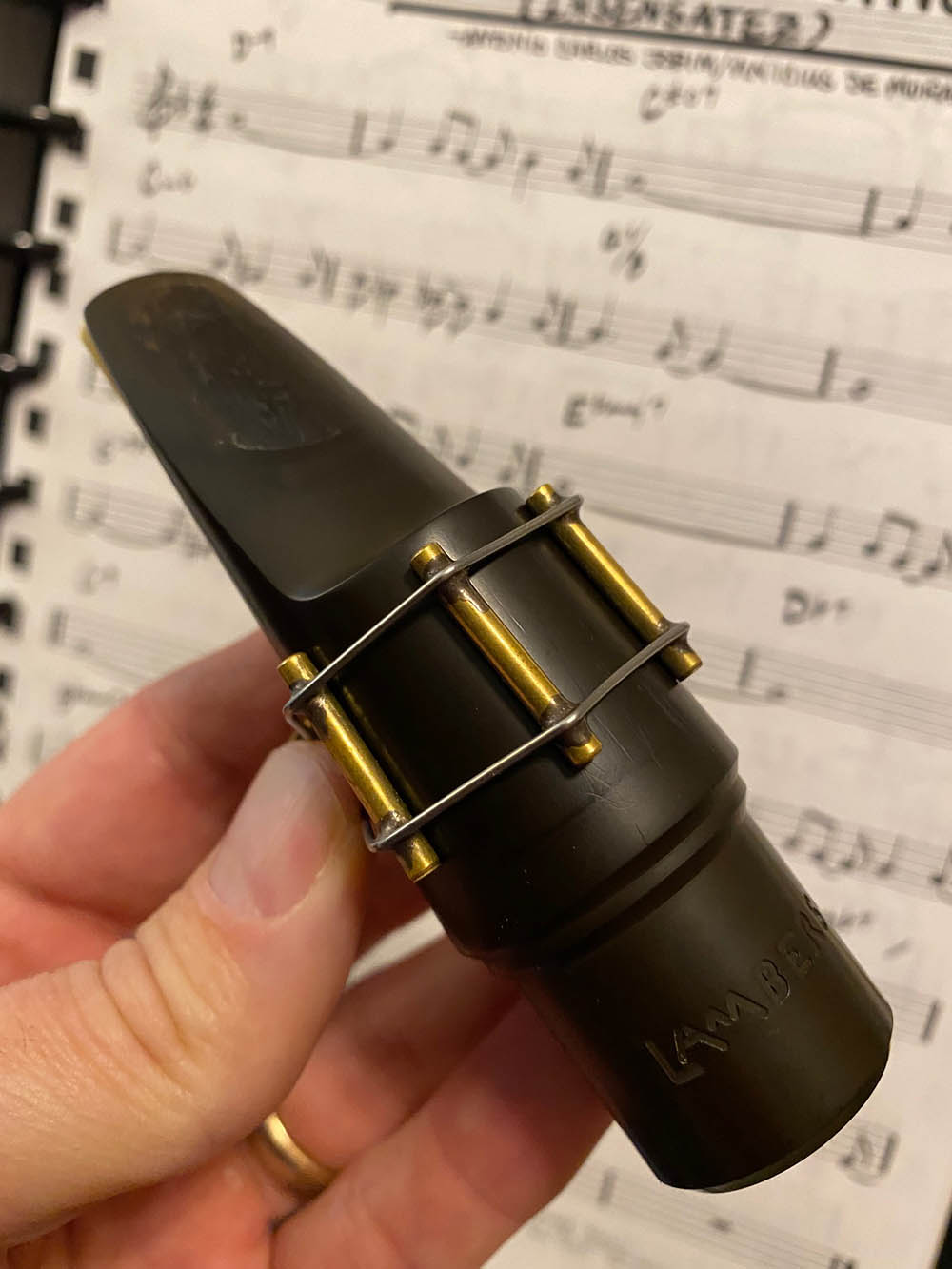
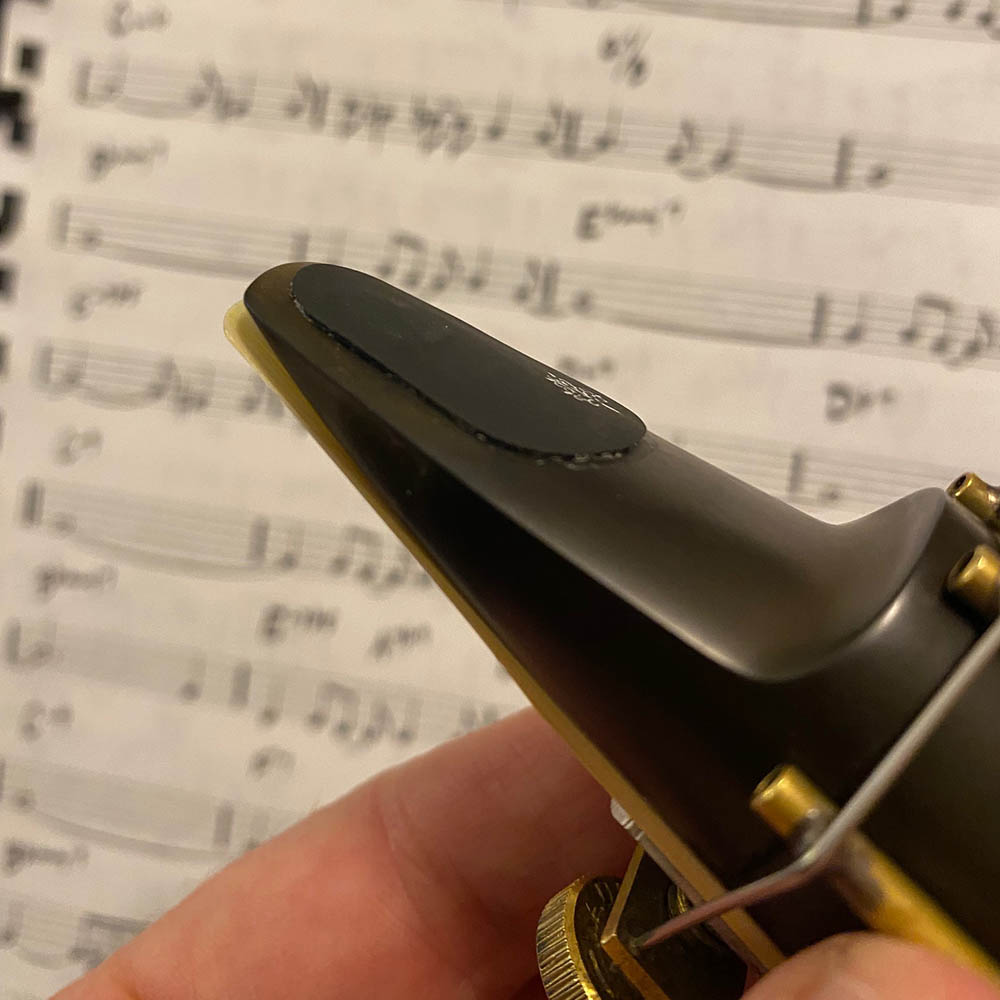
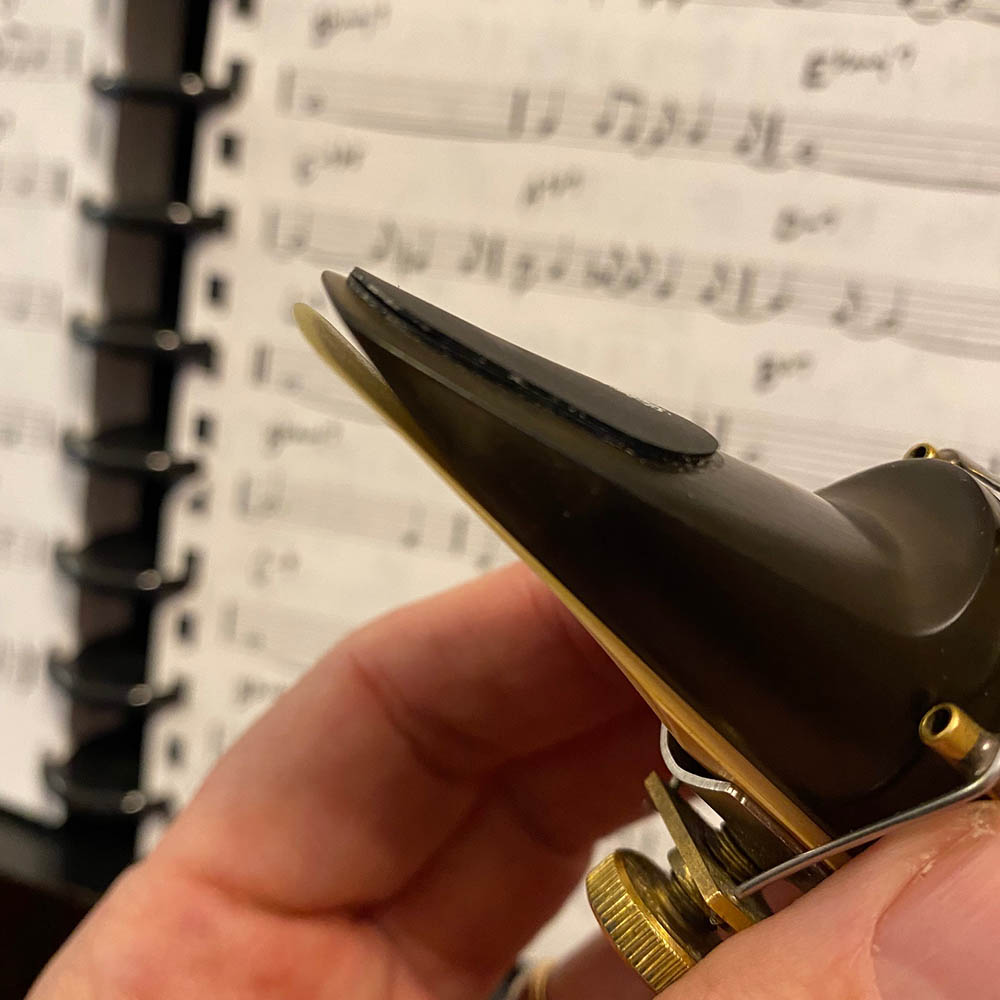
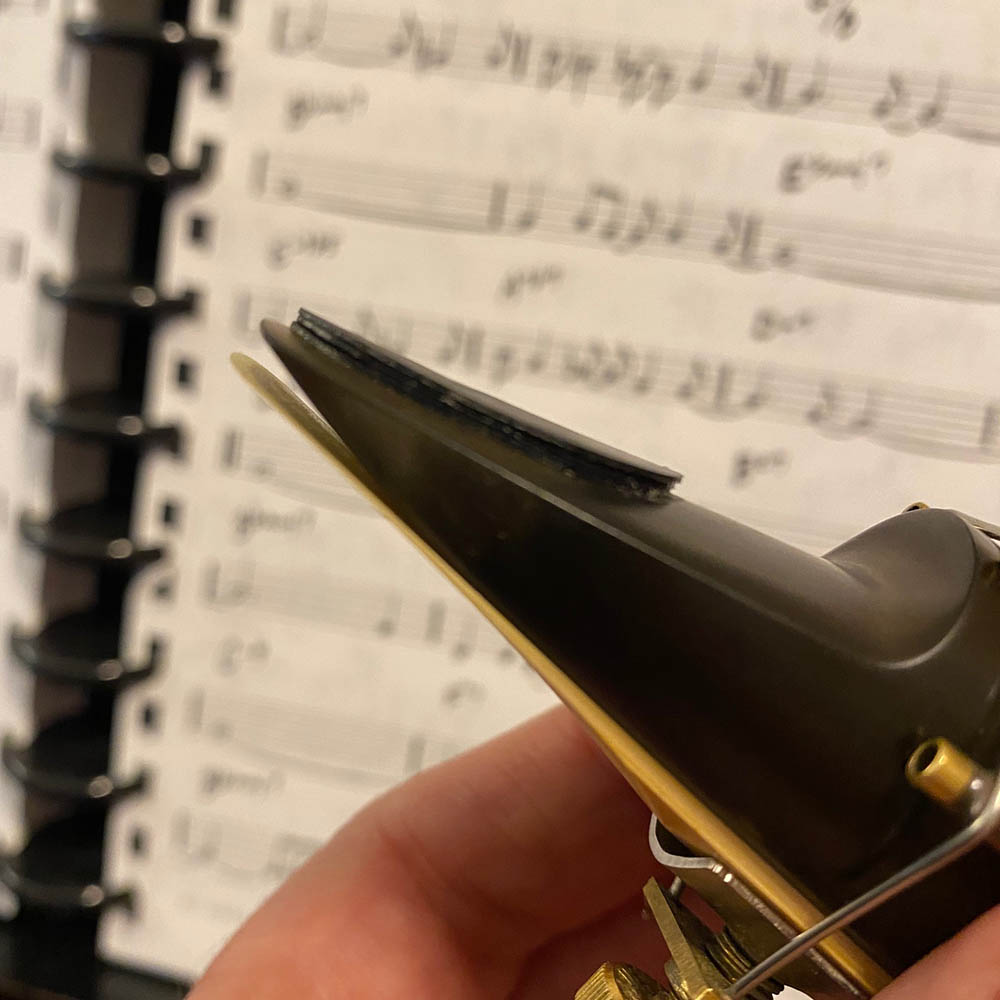
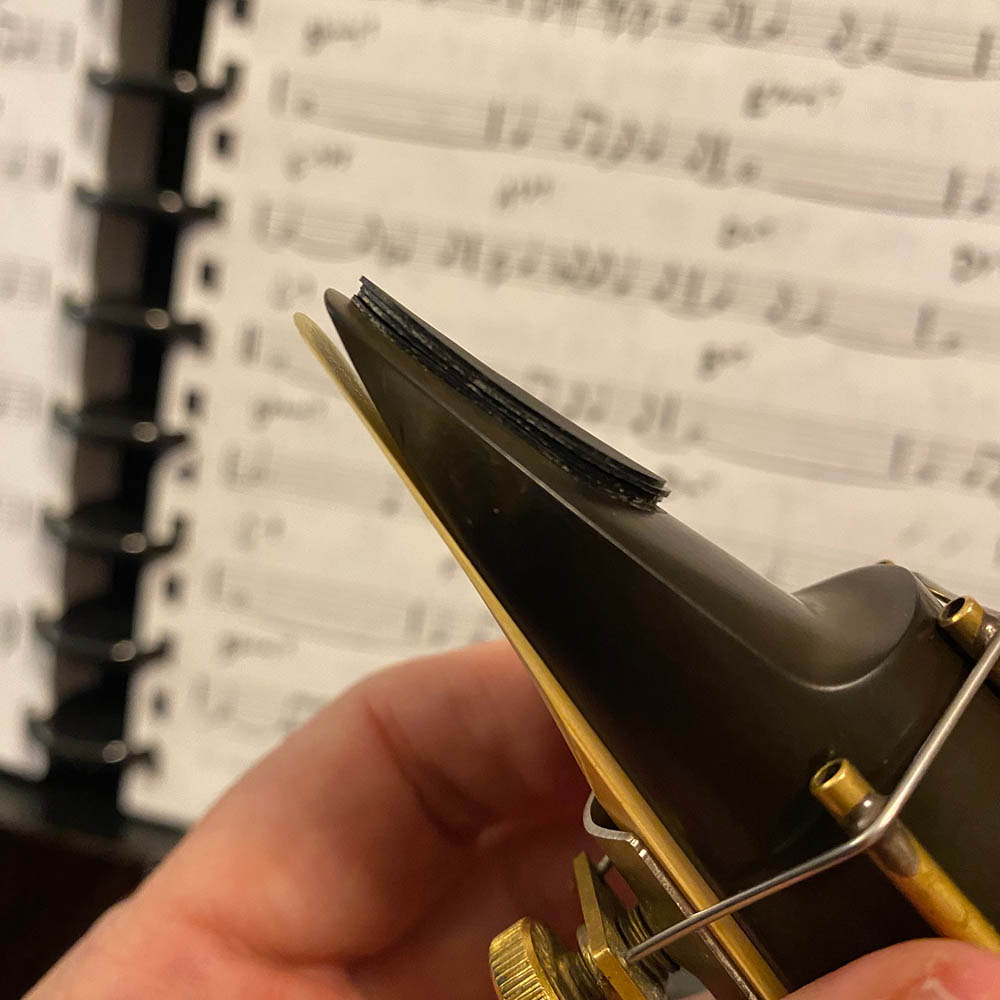
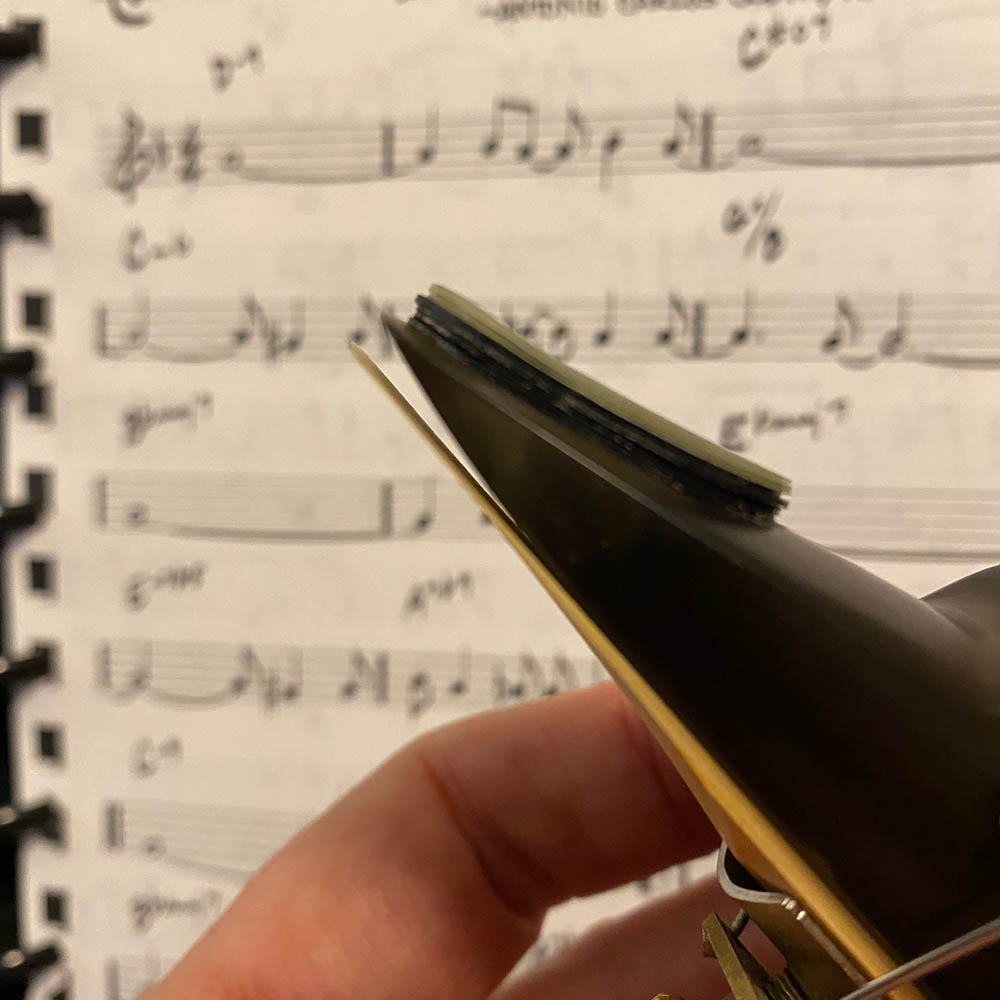
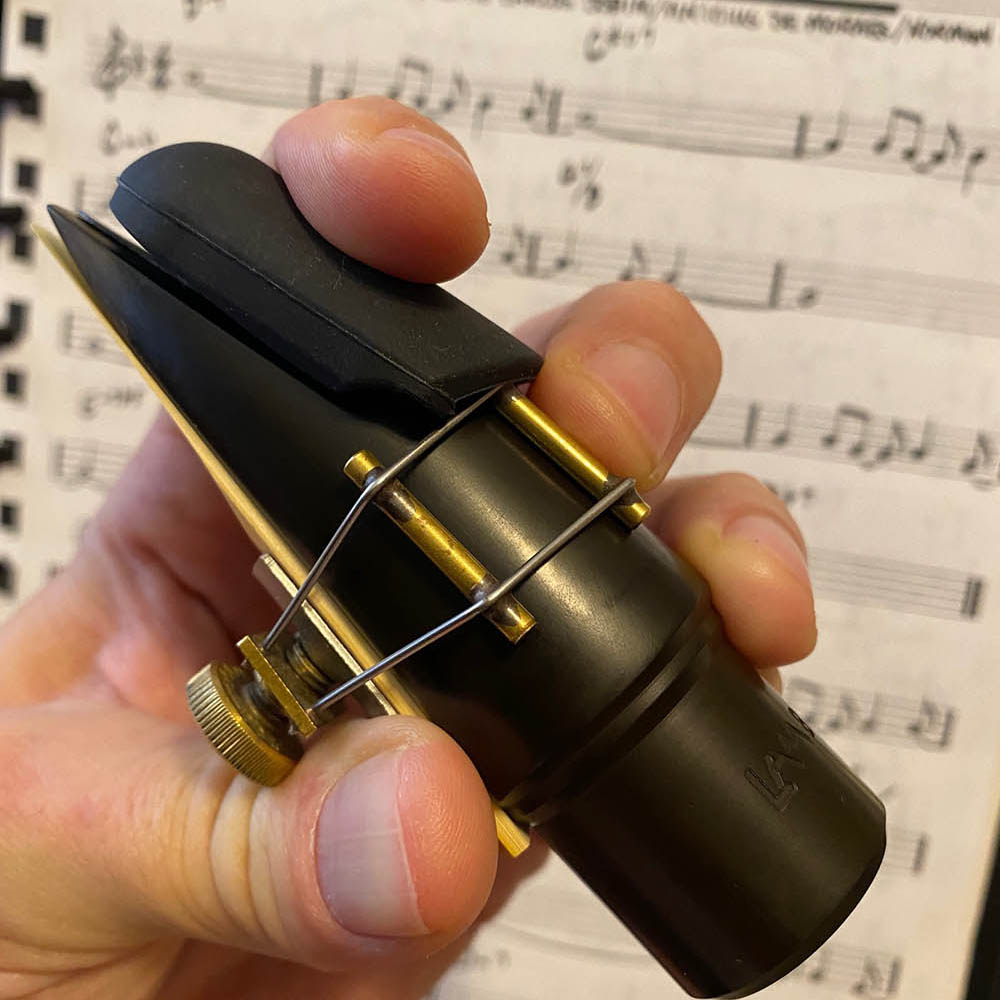
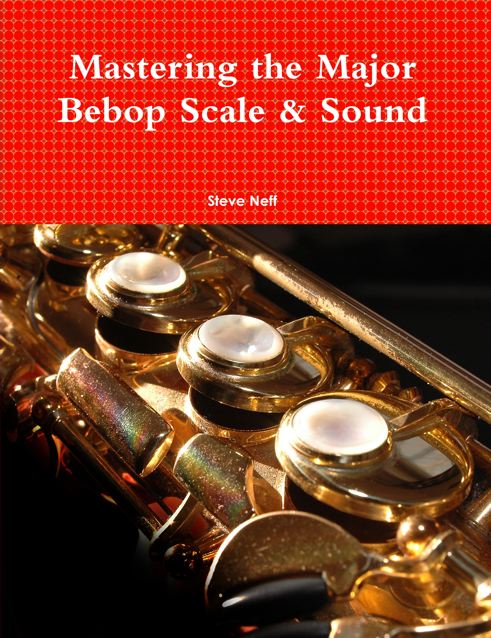


I don’t hear much difference between the recordings, but the vibrations transmitted through the players skull bones do effect the sound inside the player’s head, and that matters – at least to me. I tend to think this is why some people think metal is harsher sounding than HR and patches deaden sound. I tend to choose mouthpieces and materials more for the pleasure I get from playing them rather than something subtle I hear picked up on tape.
I think I hear the difference of no patch and one patch. After two, I really couldn’t tell. The ‘honkin’ big rubber patch did however bring out a heavier sounding low end to me.
I don’t hear much of a difference between no patch or one patch, but beyond that I can hear that your throat has to change position as you go higher. I feel a lot of classical pieces of old where fatter at the beak and made you open the oral cavity more, where as a Berg, Otto Link or any other 1950s/60’s jazz pieces were smaller at the beak. I think these subtle differences do affect how we voice our sound and would be more noticeable in you test if you played them for a much longer period of time (weeks). In the end, when adding patches, you would find a voicing that gives you the same sound that you already have. Just my 2 cents worth.
I hear some noticeable difference with the thick rubber… My thought would be that the more open jaw placement changes the internal oral cavity, resulting in a marginally darker tone. In fact, your comments about a “thin beaked piece sounding brighter” may not entirely come from less material vibrating more freely. Perhaps that, too, comes from changes to the oral cavity since the jaw is in a more closed position.
Good afternoon Steve,
I too have wandered down this path. I came up via the Teal school. I actually studied at the Teal School of Music, knew his son who was the band director at Osborn High on Detroit’s east side, this patch thing was squarely on the plate back in the 60’s. Combine that with some Marcel Mule, and one would have a fairly classical styled embouchure and sound. It wasn’t for many decades, until the internet arrived that I learned about Joe Allard. For me, the one significant “east coast” method is being able to slide up and down the beak as needed. It’s really impossible to do that with patches. So over the last decade I’ve learned that I actually like to play without a patch on certain mouthpieces, like Berg’s, which are short comparatively speaking without the patch!
The one thing that I do notice with patches, on certain mouthpieces, there’s a bit of a deadening effect. Now this is the Princess and the Pea type of thing, so not everyone can notice it, but if one is nit picking, one can tell.
So the real question is: Can the person in the audience with two drinks down, can they tell the difference? I suspect they can’t. So always play to a drink minimum.
Have a great day, and thanks for all the work you do. I enjoy the reads.
Ted
BTW, I do hear the deadening effect in your audio samples. The no patch has the most nuances going on followed by the single patch. I do like the no patch track the best. -Ted
I really don’t hear any conceivable difference. Even though I WANT to hear the last two as being slightly darker, I’m not sure they really are. (Like you say, in a blindfold test I’d be hard pressed to tell any difference). I used to use 2 patches on my wooden Lamberson (a clear patch over the black patch to stop my teeth ripping holes in it) – I made a 1-2mm dint in the Guardala patch and surrounding metal I previously played and was terrified I was going to rip holes in the wood piece. It made the piece a comfortable height for me as the beak is quite a low profile on those pieces. Interesting discussion Steve. Thanks again. Out of interest I recently played a few recording sessions using my unlacquered ’36 BA and relacquered ’41 30M tenors swapping between my metal Spencer and an HR Ambika 3 and I honestly couldn’t tell you which combo is which unless I had notes. Of course, they FEEL vastly different in so many ways. Thanks again Steve. All the best
Thanks for sharing your thoughts Julien. Wow! I have to say that I am surprised that the difference couldn’t be heard between the BA and the 30M tenors as well as the two mouthpieces. Although, so much of what we do is about what we feel and hear in the moment so maybe even if these things don’t make a huge difference to the listener they do make a huge difference to our ability to feel comfortable and play our best.
I use the Runyon clear patches. I cut them in 1/2 and get 2 out of 1….. I listened to the tracks and can hear a slight difference. It’s my belief that as experienced players our brain subconsciously makes our body adjust to get the tone we have conceived in our head, so if you play for a long enough period of time they could sound the same.
I certainly noticed a difference when you got to three patches. And between no patch and one. Beyond that, I thought it had more to do with personal comfort. I could hear you working harder to sound the way you wanted. Years ago, I drove a few friends crazy listening to oboe reeds I had made. I was convinced that the ones that were harder to play, or more resistant, had a better, darker sound. So if I had to work harder to get a dark sound, so be it. Every one of them picked out the reed that was the easiest for me to play. I try to keep that in mind. Keep it comfortable for you as a player and the listener will enjoy what you play. Sorry to be so long. Just my two cents!
I clearly hear each patch as you add patches having a “darker” resonance and not one better than the other. I have heard that the thicker the beak the darker the sound, the concept being, I’m recalling, the mouth cavity opens up more, but I have no beliefs, just ears.
Kevin Danenberg on Facebook made this statement that I thought was an amazing insight that I hadn’t thought about and wanted to share it here.
“If it changes the sound that you hear in your head, it’s going to change how you compensate to get to the sound that you *want* to hear in your head. I spent a few years practicing exclusively in a Whisper Room due to neighbor issues. Those things really eat up the treble (hence the use of bass traps in small recording rooms). Over time, I started playing brighter to compensate, and then when I played in an open room — wow, bright! So you’ll eventually adjust in some way that is audible to others. Similarly, if you play a different mouthpiece exclusively for a while, your personal tone will start coming out if it one way or another! Not that it doesn’t matter what piece you play, but we all have our ideal sound in our head and…”
I am absolutely in concordance with you observations!
It was subtle, but to me the sound differed a little as you started to add more patches: things seemed to get darker, you seemed to loose some vibrancy, and in general things seemed to sound more and more uncomfortable as you added patches.
I use one of the clear (Vandoren, D’Addario, or Runyon) mouthpiece patches because my teeth directly on the mouthpiece is really uncomfortable for me. The vibrations are almost painful. When I was younger, I would bite down on the mouthpiece. I couldn’t play without doing that. Once I tried experimenting with different mouthpiece patches, I figured out that I was biting because it made the vibrations less of an issue. But, it definitely was detrimental to my tone. Once I started using a patch, it cleared up a lot of issues I was having because I could relax my embouchure and let the reed vibrate.
I have tried the thicker black patches, but I didn’t like them. They felt too rubbery and spongy for me. I also felt like my tone was being muffled when I used them. Did it really muffle my sound? It’s debatable, all I know is that I didn’t like the way they felt.
I have noticed differences with mouthpiece beak heights. At least at first. Because beak height literally changes how much you have to open your mouth to form you embouchure and effects your oral cavity and voicing. So, it takes some time to adjust to a different mouthpiece.
So, do mouthpiece patches and beak height effect tone. I’d say yes. But, only to a point and I think the effects are subtle and the audience probably wouldn’t notice. I think the more significant difference is in the way it feels to the player.
I will add that in addition to my personal issues with the horn. I like to use mouthpiece patches because they keep your mouthpiece from getting scraped up by your teeth.
Thanks Chris for coming by and adding your insight on the subject. I posted this somewhere else but can’t find it now:
“I was taught to play with an “eeee” tongue position when playing the saxophone so that the tongue is arched up against your top molars of your top teeth. That is also what I teach my students to do. The thing I realized the other day, is that it is incredibly hard to say “eeee” while opening and closing your jaw so that the “eeeee” sound stays the same. I wonder if this change in tone to “eeeee” is similarly transferred to the saxophone tone through that tongue position and oral shape. It is very interesting to think about…….”-Steve
I was taught the same. I practiced a lot from Dave Liebman’s Developing a Personal Saxophone Sound. It’s been a while, but if memory serves, Dave also went with the “eeee” position (I should re-visit that book). I agree with you, if the beak is too high, it does make it more difficult to get the “eeee” position
I use silicone 0.3mm patches and I hardly know they are on the mouthpiece. They protect the MP and are very thin. My sound seems not to be affected.
It appears to go the opposite way from what you might expect. With more layers of rubber, the sound seems to get a tiny bit brighter and that’s exactly what I would expect. Every player who is used to his/her gear will have his/her tone dialed in and will subconsciously compensate for any “variations/imperfections”. Otherwise, everybody would sound the same and it would be just a matter of the gear and we all should know that this is not the case.
You can try to sound like Kenny G (sorry for bringing this up) but most likely you won’t succeed. Or Sanborn or Dexter, it really doesn’t matter. If you change anything on your setup, you’ll still sound about the same.
The player’s perception of his/her tone is largely a result of the transfer of the tone from the mouthpiece to the teeth and from there to the jaw and inner ear (that’s actually how the ear developed during evolution), whereas the audience will hear the sound that is projected away from the player.
If you add a patch, you will (as mentioned in the article) dampen selectively the higher frequencies and cut off a bit of the amplitude, in other words, the tone will be perceived darker and attenuated. That’s where the “compensation” kicks in, a minor change in embouchure, air speed, angle will get you back to where you want to be but the effect on the listener will be that you may be slightly louder and brighter.
This is something that originally puzzled me, whenever I heard comparison tracks between metal and Rovner ligatures where I constantly picked the wrong track in that the Rovners generally appeared to play brighter than the metal.
However, the differences are very subtle and only audible with a good equipment, preferably headphones.
Thanks for posting this, Steve, it confirmed what I believed would be the case, but as a disclaimer, I have to say that my expectations were already pre-formed and my hearing was probably biased.
Steve,
I could really hear differences each time you changed. I preferred without but with 4 and six the effect was very pronounced in a good way if one wanted bring more darkness into one´s sound. Great experiment. Ben Wendel espouses the no patch philosophy. For myself it depends on what mouthpiece I´m playing. I prefer no patch but repairing an indent on an ebonite mouthpiece is more difficult than on a Link bite plate. IMO.
Steve,
I could hear a difference between unpatched (more resonant) and patched. My approach is to use a thin, clear, smooth as possible patch (BG, VanD) on all my pieces which allows some sliding in and out of the top teeth. The thicker black ones feel like bike tube material to me and hinder that movement, if I want it, even though my top teeth are mostly in the same place on a particular mouthpiece. Just trying to avoid those dreaded tooth marks!
Steve, I proceeded like this:
having realized that by listening to the sound clips in succession the difference seemed minimal, perhaps also because the ear after a while makes it difficult to perceive the differences, as if “anesthetized”, I tried to compare the first sound clip (with no patch) with the latest (with a Big Thick Piece of Rubber): and the difference was felt.
I then tried to compare the sound clips one with each other in jumps to check with how many patches the difference was felt: at the third sound clip (with two patches), I started to hear a difference with the first sound clip (with no patch).
This is what I have perceived with unrefined computer speakers.
Giuseppe.
I correct myself; where I write: “… I then tried to compare the sound clips one with each other in jumps to check with how many patches the difference was felt …” I wanted to write
“I then tried to compare the first sound clip in succession with the others to check with how many patches the difference was felt “.
At the third sound clip (with two patches), I started to hear a difference with the first sound clip (with no patch).
I prefer the sound of the first clip without patch.
Giuseppe.
The only difference it makes is to the sound you hear in your head, as it changes how the vibrations are conducted to your hearing through the jaw bones. I reckon any differences in the recordings come from your own reaction to how you hear your sound, making you adjust how you play based on that.
I’ve always preferred the brighter side of the saxophone sound and worked hard to achieve it. To dampen it with a mouthpiece patch is not in the game for me! It tastes bad anyway.
I actually like the hard inlay on my metal mouthpiece as a strong platform for my teeth.
In your example Steve, I don’t find much difference in either with or without the patch.
The one patch on the mouthpiece, seems to be a bit softer, not the cutting edge as with no patch. Patches don’t effect the tone, only mute some of the buzz in the sound.
I agree that the patches eliminate a little of the buzz in the sound, to hear the soundclips.
However it seems that Coltrane, who had dental problems, put a simple piece of scotch tape on the tooth rest of the mouthpiece; maybe patches didn’t exist yet?
Then, I read, he even switched to double lips embouchure for a while.
Giuseppe.
Comparing adjacent tests and those separated by an interval, there is a definite improvement in low-end resonance with more patches, but there is also a dullness that occurs when more patches are added. The sweet spot seems to occur with two or three patches. There are some very prosaic reasons for the observed changes. The additional patches force a more open oral cavity, which improves low-end resonance. They also add thickness to the tip, which interferes with the airflow and thereby the overtones and responsiveness. Differences in oral cavity position and tip airflow have been proposed as factors causing hard rubber pieces to be perceived as “darker” than metal pieces. The design constraints imposed by hard rubber, not the rubber itself, result in the differences.
Since we’ve had a good demonstration of how patches can detract from the sound by interfering with airflow, we might consider how the patch should be placed so as not to interfere with overtones and response. Placement too close to the tip is not a good thing.
I developed trigeminal neuralgia as an 81 yr old playing many hours daily. Put on 5 patches to open jaw. Still have pain. Your demos sounded darker with increased thickness. Don’t over play.
Ugh! I had trigeminal neuralgia as well for a few months. What an awful and painful experience. Of course, they then gave me Tegretol for it which come to find out I am deathly allergic to….. I’m sorry you have to experience this at 81 years old.